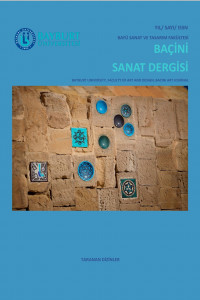MEDYA VE FAS KAMUSAL ALANINDAKİ DİNİ SÖYLEMİN ARABULUCULUĞU
Bu makale, arabuluculuk veya medyalaştırma kavramının tanımı ve işlevlerinin yanı sıra dönüşüm, bağlamsallaştırma, haberleri çerçeveleme, aktörler olarak medya vb. gibi sürecin temel kavramlarına dayanarak başlamaktadır. Fas'ın kamusal alanında dinin nasıl aracılandığını gözlemlemek amaçlanmaktadır. Dolayısıyla medyatik bir din, medyadan geçtiği için pratiğinde dönüşümler geçirmiş bir dindir. Fas'ta farklı medya türlerinin dini sembollerin ve anlamların üretilmesine ve bunların toplumda tüketilmesine, yani arabuluculuk veya medyalaştırmaya müdahalesi nedeniyle İslam pratiğinin, geçirdiği dönüşümleri kimse inkar edemez. dinin. Fas'ta İslam aracılığının sonuçları arasında, belirli dini davranışlarla bağlantılı belirli yönler vardır.
Anahtar Kelimeler:
Arabuluculuk, Fas, Güç, Kamusal Alan, Din, Dini Kamuoyu
THE MEDIA AND THE MEDIATION OF RELIGIOUS DISCOURSE IN THE MOROCCAN PUBLIC SPACE
Based on this definition of the notion of mediation or mediatisation and its functions, and based on the central concepts of this process, such as transformation, contextualisation, framing the news, the media as actors, etc., we start, in this article, to observe how religion is mediatised in the Moroccan public space. Therefore, a mediatised religion is one that has undergone transformations in its praxis due to the fact that it has passed through the media. No one can deny the transformations that the praxis of Islam in Morocco has undergone due to the intervention of different types of media in the production of religious symbols and meanings, and in their consumption in Moroccan society, that is, due to the mediation or mediatisation of religion. Among the consequences of the mediation of Islam in Morocco are certain aspects linked to certain religious behaviours.
Keywords:
Mediation, Morocco, Power, Public Sphere, Religion, Religious Public Opinion,
___
- Barbero, M. & Roche, F. L. (1987). Cultura, medio y sociedad. Universidad nacional de Colombia
- Barret, E. (ed.) (1989) The society of the text: Hypertext, hypermedia and the Social Construction of information. MIT Press.
- Bauer, M. & Gaskell, G. (Eds). (2000). Qualitative researching with text, image, and sound. Sage Publication.
- Bourquia, R et Al. (Ed).(2000). Les jeunes et les valeurs religieuses. Edif.
- Bruno E. (1987). L‘islamisme radical. Hachette.
- Burgat F. (1995). L’islamisme en face. La découverte.
- Dader, J. L. (1992). El periodista en el espacio público. Bosh Casa Editorial,
- El Mouden, M. (2009): Los medios de comunicación islámicos en Marruecos. El ancho estrecho: las dos orillas de los medios de comunicación, 91-107. Barcelona. Icaria.
- El Ouazzani, M. H. (n. d.): Vida y yihad. Institución de Jawad for Impresión and Edición.
- Graham W. & Michael H. (Editors). (2008). The new visibility of religion: Studies in religion and cultural hermeneutics. Copyrighted Material.
- Habermas, J. (1981): Historia y crítica de la opinión pública. Gustavo Gili, Serie Mass Media.
- Hmimnat, S. (2009). Moroccan Islam in the official ideological discourse. En Wijahat Nadar, 39, 8-13.
- Hoover. S. M. (2006). Religion in the media age. Routledge.
- Ibahrine, M. (2005). The internet and Politics in Morocco: The Political Use of the internet by Islam-Oriented political Movement [Doctoral thesis]. Universitat Hamburg
- Inger L., Jeanne S. & Torben V. (2006). Mediating ideology in text and image: ten critical studies. John Benjamins B.v.
- Informe (2009). The report on the religious situation in Morocco 2007/2008. Rabat Ed. The Moroccan Centre for Modern Studies and Research.
- Las Radios Privadas En La Experiencia Marroquí (2010). Conference organized by the Moroccan Centre for Modern Studies and Research. 18 de diciembre de 2010. Rabat.
- Majdoubi, H. B. (2010). The independent press in Morocco. Wijahat Nadar, 44-45(12).
- Majdoubi, H. B. (2011). The decisive role of the media in the Arab democratic revolutions. Revista: Wijdjhat Nadar, 49(14).
- McCombs M. E. (2004). Setting the agenda: the mass media and public opinion. Polity Press
- Monzón, C. (1987). La opinión pública: Teorías, conceptos y métodos. Tecno.
- Başlangıç: 2023
- Yayıncı: Bayburt Üniversitesi
Sayıdaki Diğer Makaleler
MEDYA VE FAS KAMUSAL ALANINDAKİ DİNİ SÖYLEMİN ARABULUCULUĞU
TÜRK ÇİNİ SANATINDA BİR TEKNİK: BAÇİNİ
Yavuz Kaan KONUK, Umut Barış USTABULUT, Furkan BAYRAK
KASTAMONU ÇEŞMELERİNİN TİPOLOJİK AÇIDAN İNCELENMESİ
SAHTE HABER VE KÜRESEL ENFORMASYON: HAKİKATİ ARAMAK İÇİN BAKIŞ AÇILARI VE PERSPEKTİFLER
